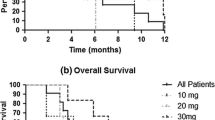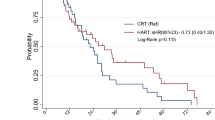Abstract
To evaluate the safety and efficacy of postoperative proton beam therapy (PBT) combined with nimustine hydrochloride (ACNU) or temozolomide (TMZ) for glioblastoma multiforme (GBM). The subjects were 46 patients with GBM who were treated with high dose (96.6 GyE) PBT. There were 24 males and 22 females, and the median age was 58 years old (range 24–76). The Karnofsky performance status was 60, 70, 80, 90 and 100 in 5, 10, 12, 11 and 8 patients, respectively. Total resection, partial resection, and biopsy were performed for 31, 14 and 1 patients, respectively. Photon beams were delivered to high intensity areas on T2-weighted magnetic resonance imaging (MRI) in the morning (50.4 Gy in 28 fractions). More than 6 h later, PBT was delivered to the enhanced area plus a 10 mm margin in the first half of the protocol (23.1 GyE in 14 fractions) and to the enhanced volume in the second half (23.1 GyE in 14 fraction). Concurrent chemotherapy with ACNU during weeks 1 and 4 or daily TMZ was administered in 23 and 23 patients, respectively. The overall 1 and 2 year survival rates were 82.6 and 47.6 %, respectively. Median survival was 21.1 months (95 % CI 13.1–29.2), with no significant difference in survival between the ACNU and TMZ groups. The patient characteristics were similar in the two groups. Late radiation necrosis occurred in 11 patients (six ACNU, five TMZ), but was controlled by necrotomy and therapy including bevacizumab. PBT concurrent with ACNU or TMZ was tolerable and beneficial for carefully selected patients with GBM.



Similar content being viewed by others
References
Walker MD, Strike TA, Sheline GE (1979) An analysis of dose–effect relationship in the radiotherapy of malignant gliomas. Int J Radiat Oncol Biol Phys 5:1725–1731
Walker MD, Green SB, Byar DP et al (1980) Randomized comparisons of radiotherapy and nitrosoureas for the treatment of malignant glioma after surgery. N Engl J Med 303:1323–1329
Keime-Guibert F, Chinot O, Taillandier L et al (2007) Radiotherapy for glioblastoma in the elderly. N Engl J Med 356:1527–1535
Fine HA, Dear KB, Loeffler JS et al (1993) Meta-analysis of radiation therapy with and without adjuvant chemotherapy for malignant gliomas in adults. Cancer 71:2585–2597
Stewart LA (2002) Chemotherapy in adult high-grade glioma: a systematic review and meta-analysis of individual patient data from 12 randomised trials. Lancet 359:1011–1018
Athanassiou H, Synodinou M, Maragoudakis E et al (2005) Randomized phase II study of temozolomide and radiotherapy compared with radiotherapy alone in newly diagnosed glioblastoma multiforme. J Clin Oncol 23:2372–2377
Stupp R, Mason WP, van den Bent MJ et al (2005) Radiotherapy plus concomitant and adjuvant temozolomide for glioblastoma. N Engl J Med 352:987–996
Stupp R, Dietrich PY, Ostermann Kraljevic S et al (2002) Promising survival for patients with newly diagnosed glioblastoma multiforme treated with concomitant radiation plus temozolomide followed by adjuvant temozolomide. J Clin Oncol 20:1375–1382
Gilbert MR, Dignam JJ, Armstrong TS et al (2014) A randomized trial of bevacizumab for newly diagnosed glioblastoma. N Engl Med 370:699–708
Chinot OL, Wick W, Mason W et al (2014) Bevacizumab plus radiotherapy-temozolomide for newly diagnosed glioblastoma. N Engl Med 370:709–722
Tanaka M, Ino Y, Nakagawa K et al (2005) High-dose conformal radiotherapy for supratentorial malignant glioma: a historical comparison. Lancet 6:953–960
Fitzek MM, Thornton AF, Rabinov JD et al (1999) Accelerated fractionated proton/photon irradiation to 90 cobalt gray equivalent for glioblastoma multiforme: results of a phase II prospective trial. J Neurosurg 91:251–260
Iuchi T, Hatano K, Kodama T et al (2014) Phase 2 trial of hypofractionated high-dose intensity modulated radiation therapy with concurrent and adjuvant temozolomide for newly diagnosed glioblastoma. Int J Radiat Oncol Biol Phys 88:793–800
Mizumoto M, Tsuboi K, Igaki H et al (2010) Phase I/II trial of hyperfractionated concomitant boost proton radiotherapy for supratentorial glioblastoma multiforme. Int J Radiat Oncol Biol Phys 77:98–105
Mizumoto M, Yamamoto T, Takano S et al (2015) Long-term survival after treatment of glioblastoma multiforme with hyperfractionated concomitant boost proton beam therapy. Pract Radiat Oncol 5:e9–e16
Cancer Therapy Evaluation Program (2006) Common terminology criteria for adverse events v3.0 (CTCAE). Cancer Therapy Evaluation Program, Bethesda, MD. http://ctep.cancer.gov/protocolDevelopment/electronic_applications/ctc.htm
Sultanem K, Patrocinio H, Lambert C et al (2004) The use of hypofractionated intensity-modulated irradiation in the treatment of glioblastoma multiforme: preliminary results of a prospective trial. Int J Radiat Oncol Biol Phys 58:247–252
Mirimanoff RO, Gorlia T, Mason W et al (2006) Radiotherapy and temozolomide for newly diagnosed glioblastoma: recursive partitioning analysis of the EORTC 26981/22981-NCIC CE3 phase III randomized trial. J Clin Oncol 24:2563–2569
Matsuo M, Miwa K, Tanaka O et al (2012) Impact of [11C]methionine positron emission tomograpy for target definition of glioblastoma multiforme in radiation therapy planning. Int J Radiat Oncol Biol Phys 82:83–89
Iuchi T, Hatano K, Uchino Y et al (2015) Methionine uptake and required dose to control glioblastoma. Int J Radiat Oncol Biol Phys 93:133–140
Bui QC, Lieber M, Withers HR et al (2004) The efficacy of hyperbaric oxygen therapy in the treatment of radiation-induced late side effects. Int J Radiat Oncol Biol Phys 60:871–878
Yonezawa S, Miwa K, Shinoda J et al (2014) Bevacizumab treatment leads to observable morphological and metabolic changes in brain radiation necrosis. J Neurooncol 119:101–109
Lubelski D, Abdullah KG, Weil RJ et al (2013) Bevacizumab for radiation necrosis following treatment of high grade glioma: a systematic review of the literature. J Neurooncol 115:317–322
Furuse M, Nonoguchi N, Kawabata S et al (2013) Bevacizumab treatment for symptomatic radiation necrosis diagnosed by amino acid PET. Jpn J Clin Oncol 43:337–341
Matsuda M, Yamamoto T, Ishikawa E et al (2011) Prognostic factors in glioblastoma multiforme patients receiving high-dose particle radiotherapy or conventional radiotherapy. Br J Radiol 84:S54–S60
Acknowledgments
This work was partially supported by grants-in-aid for Scientific Research (B) (15H04901) and Young Scientists (B) (25861064) from the Ministry of Education, Culture, Sports, Science and Technology of Japan.
Author information
Authors and Affiliations
Corresponding author
Rights and permissions
About this article
Cite this article
Mizumoto, M., Yamamoto, T., Ishikawa, E. et al. Proton beam therapy with concurrent chemotherapy for glioblastoma multiforme: comparison of nimustine hydrochloride and temozolomide. J Neurooncol 130, 165–170 (2016). https://doi.org/10.1007/s11060-016-2228-4
Received:
Accepted:
Published:
Issue Date:
DOI: https://doi.org/10.1007/s11060-016-2228-4




